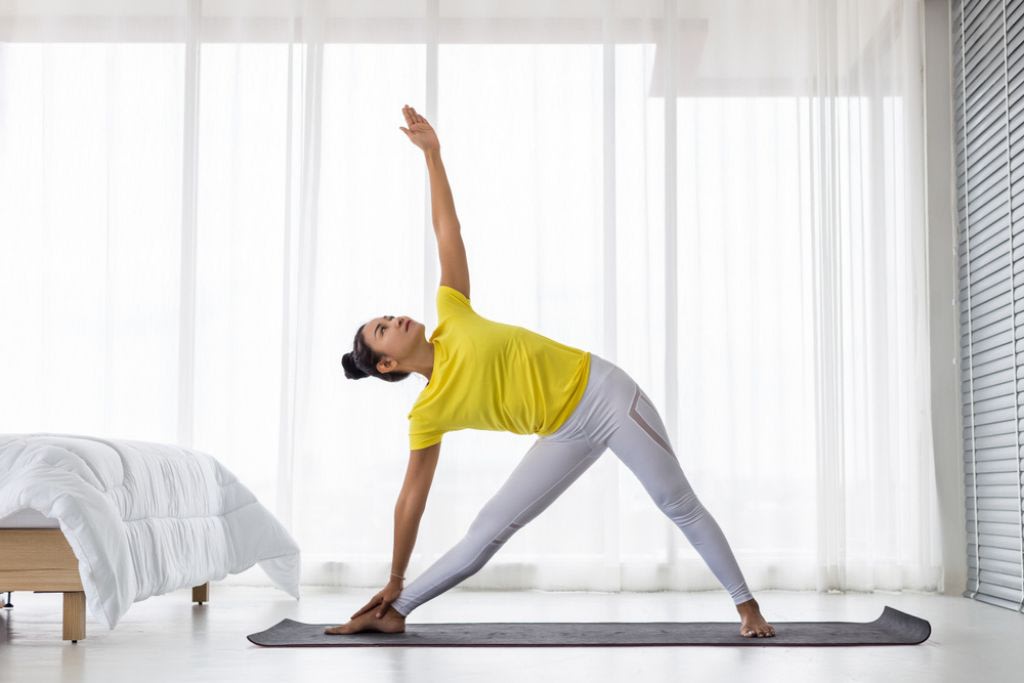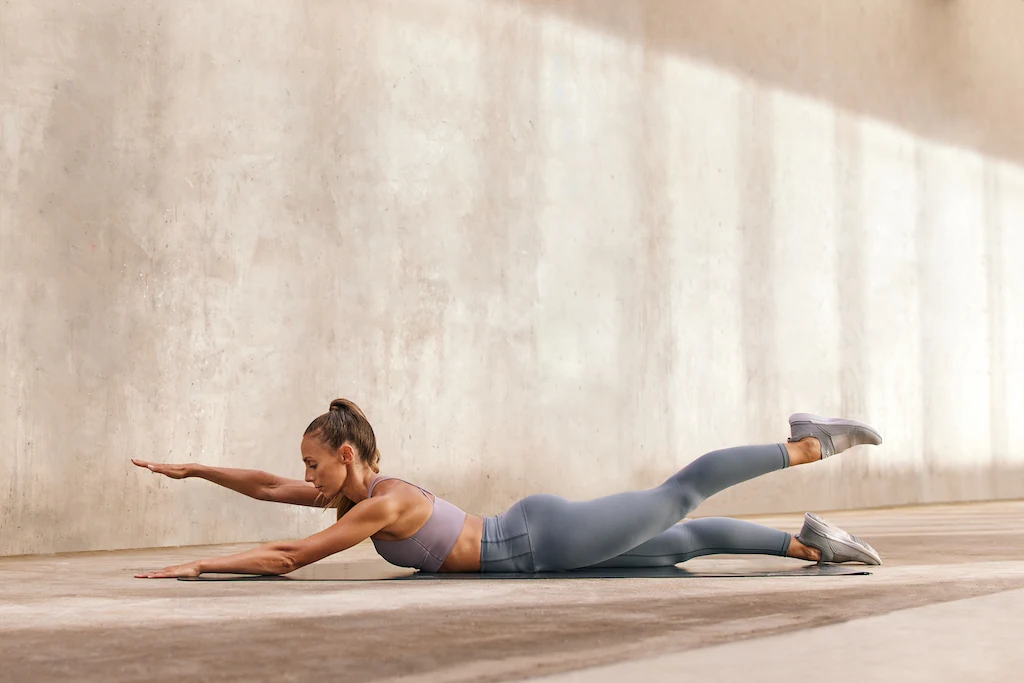How To Do Pilates At Home

April 9, 2020

If you’re looking for a training style that is perfect for working out at home, doesn’t require equipment and is low-impact on your joints, Pilates is a great option! Pilates workouts will have you feeling the full-body burn with the added bonus of being well-suited to small or quiet spaces - meaning happy neighbours if you live in an apartment.
If you’re following another Sweat program, the occasional Pilates workout can help to spice things up and prevent workout boredom, while complementing other forms of exercise you enjoy by improving your core strength, stability and range of motion. Here’s what you need to know before you start doing Pilates at home.
Jump to:
Things to know about Pilates
One of the best things about Pilates is how little you need to get started, in terms of equipment and your fitness level. Grab a yoga mat, get dressed in some comfortable workout clothes, find enough space to move and you’re ready to begin!
Pilates is all about muscular control and quality movement, so don’t be fooled by the lack of equipment - even a bodyweight workout at home will have your muscles burning and shaking in no time.
Pilates is also a great training option for every fitness level. You can start with your bodyweight, easier variations and more rest if you’re a beginner, and then make your workouts more challenging as you progress. Using dumbbells, hand weights, ankle weights or a resistance band, attempting more challenging exercise variations, and reducing your rest periods are all great ways to increase the intensity.
The trick with Pilates is to take your time to master the correct form and make sure you’re activating the right muscles. This can take a lot of focus and control (physically and mentally), but your efforts will pay off as you build strength, mobility, your mind-body connection, and can move on to advanced exercises knowing you’ve mastered your form.
If this is your first time trying Pilates, try to be patient with yourself and concentrate on engaging each muscle during the exercises. Don’t forget to keep breathing - it’s easy to hold your breath during Pilates!
If you prefer high-intensity workouts, don't be fooled into thinking Pilates is easy. Sara Colqhoun has created High-Intensity Interval Pilates (HIIP) classes that will definitely have you feeling the burn! You can try them in her program Pilates with Sara, available exclusively on the Sweat app.
Tips for your first Pilates workout
Here are a few tips to make sure that you are comfortable and to help you maintain proper form while doing Pilates at home.
Here are a few tips to make sure you are comfortable, know how to maintain proper form and get the most out of your Pilates workout at home.
Wear suitable clothing
Choose comfortable workout clothing that allows you to move freely. It’s a good idea to avoid zips, drawstrings, seams or buttons that might press into your body when lying on your front, back or side, and people often prefer form-fitting clothes to avoid any baggy fabric getting in the way or causing friction. Make sure you have a water bottle and sweat towel nearby, too!
Be patient
If you’re new to Pilates, you may find it quite challenging due to the control, focus, balance and strength it requires, so patience is your best friend. If learning a new movement is difficult, you need to take extra breaks, or you don’t feel like it’s getting easier, hang in there! With patience and consistency your skills will build and you’ll make progress.
Ground your feet
You won’t need shoes for a Pilates session, but it’s up to you whether you go barefoot or wear grip socks, which can be a great option to avoid slipping if you’re someone who sweats a lot or you find you’re sliding around on your yoga mat.
Move with your breath
Pilates requires you to concentrate and hold positions that can make it challenging to breathe normally, especially when it comes to those movements that really work your core! Throughout your Pilates routine, focus on moving with your breath. As you hold a more strenuous position, use your breath as a point of focus to help you to hold the position. Inhale through your nose and exhale through your mouth.
Control is king
If you’re used to smashing out squat jumps and burpees as fast as you can, the pace of Pilates might take some getting used to. To make your workout effective, you want your movements to be steady and controlled, so take a moment to reset if you find you’re rushing through each movement with speed or using momentum.
Mobilise your neck
Between each exercise and after your workout, gently rotate your head from side to side so that your neck doesn’t become stiff.

Beginner Pilates exercises to try at home
Here are six basic Pilates exercises you can try at home. Before you begin, it can also help to engage your core and take some deep breaths.
Glute bridge
Engage your core and glutes and move with control for this exercise to be most effective.
Lie on your back with your knees bent. Your feet should be flat on the mat with your arms by your sides.
Exhale, squeezing your glutes to raise your hips towards the sky until your body forms a straight line from knee to head.
Lower slowly back to the floor, thinking about lowering your spine to the mat one vertebrae at a time. This visualisation can help to keep your core engaged.
Repeat for 5-8 repetitions.
Roll-up
Roll-ups targets your abdominals, but for it to be most effective, you need to avoid the temptation to rush through the movement or use momentum. Be patient and focus on rolling your body up and down with steady control for the best results.
Lie on your back with your legs extended and your arms straight behind your head.
Engage your core by thinking about connecting your spine to the floor, lift your head and raise your arms toward the ceiling to roll up smoothly.
Reach your arms forward towards your toes as far as you can, drawing your abdominals toward your spine.
Slowly roll back down with control, thinking about connecting your spine with the mat one vertebrae at a time until you’re back to the starting position.
Repeat for 5-8 repetitions.
Remember to breathe throughout this movement and keep your arms and legs straight to maximise core engagement.
Single leg circle
This classic Pilates exercise increases core strength and pelvic stability while strengthening your hamstrings and quads.
Lie on your back with your legs extended and engage your core by thinking about connecting your spine to the floor and drawing your belly button to your spine..
Draw one knee to your chest, then extend it straight up towards the ceiling. Inhale.
With control, make a large circular motion with your extended leg, moving it over your body, down towards your outstretched leg, over to the opposite side and up to return to the starting position.
Complete 5-8 circles in one direction, then reverse the direction, exhaling as you extend the leg to the side, before circling your leg in the opposite direction for another 5-8 reps.
Repeat on the opposite leg.
Single leg stretch
This exercise targets your lower abs and helps you to build core strength and stability. It’s a great exercise to include in your routine if you like to hike, swim, run or cycle.
Lie on your back with your back pressed against the floor and your legs in the tabletop position with your knees bent and shins parallel to the floor. Take a few deep breaths.
Exhale, engage your core and curl your head and shoulders up to lift your shoulder blades off the ground. As you lift your head and chest up, straighten your left leg to a 45-degree angle, and hug your right knee in towards your chest with your hands on your shin.
Inhale to switch legs with control, extending your right leg out straight and bringing your left knee towards your chest.
Repeat, changing legs steadily with your breath for up to 10 repetitions.

Swimming
When you’ve done a lot of ab work, a back extension exercise like Pilates swimming can help restore balance to your body. While you’ll still need to keep your abs engaged throughout the exercise, especially your obliques, this movement targets your hamstrings, glutes and lower back.
Lie face down with your legs straight and together and your arms stretched overhead.
Lift your head, legs and arms off the floor, focusing on drawing your shoulders back and down, squeezing your glutes, and extending your body to engage the muscles in your arms and legs.
Start to perform a swimming motion, slightly lifting your right arm and left leg, then swapping sides. Breathe in for five pulses and out for five pulses.
Repeat, alternating sides, for two or three full cycles of breath.
The Hundred
This is a signature Pilates move and the key is your breath! Breathe into your back and lower ribs to make sure you use your full lung capacity, and be sure to engage your abdominals.
Lie on your back and raise your legs into tabletop position, so that your shins are parallel to the floor and your thighs are at 90 degrees. Inhale.
Exhale and engage your core. Stretch out your legs to a raised diagonal position that you can hold steadily without letting your spine lift off the mat. The lower your feet are to the floor, the more challenging it will be. Extend your arms straight and low, with your palms facing down and hovering a few inches off the floor.
Holding this position, take five short breaths in through your nose and five short breaths out through your mouth. As you hold this position, pump your arms up and down through a small range of motion, keeping your shoulders and neck relaxed throughout. Use your abdominals to hold your body still as you breathe and pump your arms.
Aim for a cycle of ten full breaths, with each breath made up of five short in breaths and five short out breaths.
Gently lower your head and feet back to the mat. To help keep your neck and shoulders in the correct position throughout, try to imagine holding an egg between your chin and chest as you gaze forward, rather than pointing your chin towards the ceiling which can strain your neck.
If you have any neck issues, you can do this exercise with your head on the ground, using your abdominals to hold your legs in an elevated position.
Experience the benefits of at-home Pilates
When you practise Pilates consistently, even just once or twice each week for 20-60 minutes, you’ll begin to reap the rewards of better core stability, muscle strength and control, and enhanced overall wellbeing.
No matter what your go-to training style is, changing it up with Pilates can help you build stronger, more integrated movement patterns that will benefit you - even when you’re not working out!
Try Pilates with Sara in the Sweat app today!

A more empowered you starts with Sweat, and our editorial team is here to bring you the latest fitness tips, trainer recommendations, wellbeing news, nutritional advice, nourishing recipes and free workouts.
* Disclaimer: This blog post is not intended to replace the advice of a medical professional. The above information should not be used to diagnose, treat, or prevent any disease or medical condition. Please consult your doctor before making any changes to your diet, sleep methods, daily activity, or fitness routine. Sweat assumes no responsibility for any personal injury or damage sustained by any recommendations, opinions, or advice given in this article.
Fitness